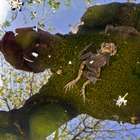Machine Wilderness
The challenges associated with the anthropocene make evident that the Earth’s systems do not exist separate to human activities. Natural processes flow unstoppably into human infrastructures and whatever human culture produces is embedded within natural systems. The emerging climate crisis and environmental damage show that our design processes underestimate the level of exposure of our landscapes to human activity. Our infrastructures, technologies and machines are not temporary visitors to our landscapes, they are permanent inhabitants.
Machine Wilderness explores what our technologies could look like if they aligned to ecological boundaries in our landscapes, becoming part of material flows, foodchains and layers of communication. In particular it looks at environmental robotics, designing ‘pseudo-organisms’ that relate to specific habitats. This program starts from the viewpoint of an organism as an expression of it’s habitat and works within a longterm view of interacting populations surfing collectively on the geological and meteorological currents that carry them.
The words machine and robot are not used here in the sense of devices aimed at efficiently performing a rudimentary utilitarian task, but rather as subtle man-made nodes that act according to flows and processes. At what level of subtlety and sympathy does a machine cease to be a machine in it’s classic sense? How can our technology relate to the subtleties and grace exhibited by biological organisms and the timeframes of natural cycles? To explore these questions Machine Wilderness explores experimental design methods that aim to include diverse ways of knowing. In collaboration with artists, ecologists, engineers, choreographers, designers, environmental philosophers, farmers and many others from diverse backgrounds we aim to trace out new contours and map new domains for ecological robotics based on specific landscapes, ecosystems, habitats and locations.
Program: includes a symposium, workshop-series and expeditions aimed at in-situ prototyping.
more info: http://machinewilderness.net/
sign up for the newsletter, with updates and open calls: newsletter
note: Machine Wilderness was the theme given by curator Andrea Polli to the wonderful ISEA 2012 symposium, and originates from writings by cultural geographer Ron Horvath in the 1960s. It is used here with full respect for that context.
Created: 15 Sep 2015 / Updated: 23 Oct 2021







